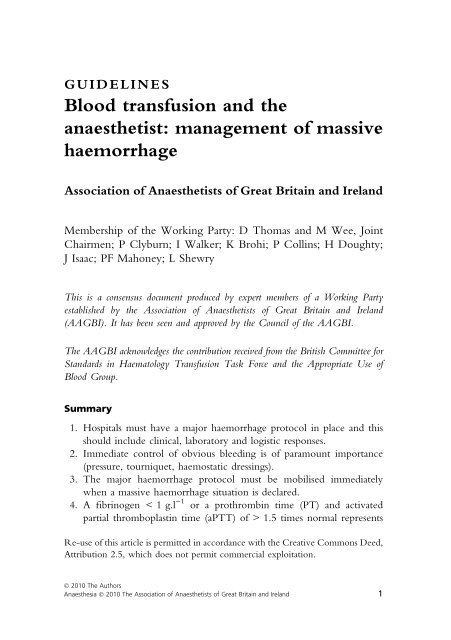Blood transfusion and the anaesthetist: management of ... - aagbi
Blood transfusion and the anaesthetist: management of ... - aagbi
Blood transfusion and the anaesthetist: management of ... - aagbi
Create successful ePaper yourself
Turn your PDF publications into a flip-book with our unique Google optimized e-Paper software.
GUIDELINES<br />
<strong>Blood</strong> <strong>transfusion</strong> <strong>and</strong> <strong>the</strong><br />
anaes<strong>the</strong>tist: <strong>management</strong> <strong>of</strong> massive<br />
haemorrhage<br />
Association <strong>of</strong> Anaes<strong>the</strong>tists <strong>of</strong> Great Britain <strong>and</strong> Irel<strong>and</strong><br />
Membership <strong>of</strong> <strong>the</strong> Working Party: D Thomas <strong>and</strong> M Wee, Joint<br />
Chairmen; P Clyburn; I Walker; K Brohi; P Collins; H Doughty;<br />
J Isaac; PF Mahoney; L Shewry<br />
This is a consensus document produced by expert members <strong>of</strong> a Working Party<br />
established by <strong>the</strong> Association <strong>of</strong> Anaes<strong>the</strong>tists <strong>of</strong> Great Britain <strong>and</strong> Irel<strong>and</strong><br />
(AAGBI). It has been seen <strong>and</strong> approved by <strong>the</strong> Council <strong>of</strong> <strong>the</strong> AAGBI.<br />
The AAGBI acknowledges <strong>the</strong> contribution received from <strong>the</strong> British Committee for<br />
St<strong>and</strong>ards in Haematology Transfusion Task Force <strong>and</strong> <strong>the</strong> Appropriate Use <strong>of</strong><br />
<strong>Blood</strong> Group.<br />
Summary<br />
1. Hospitals must have a major haemorrhage protocol in place <strong>and</strong> this<br />
should include clinical, laboratory <strong>and</strong> logistic responses.<br />
2. Immediate control <strong>of</strong> obvious bleeding is <strong>of</strong> paramount importance<br />
(pressure, tourniquet, haemostatic dressings).<br />
3. The major haemorrhage protocol must be mobilised immediately<br />
when a massive haemorrhage situation is declared.<br />
4. A fibrinogen < 1 g.l )1 or a prothrombin time (PT) <strong>and</strong> activated<br />
partial thromboplastin time (aPTT) <strong>of</strong> > 1.5 times normal represents<br />
Re-use <strong>of</strong> this article is permitted in accordance with <strong>the</strong> Creative Commons Deed,<br />
Attribution 2.5, which does not permit commercial exploitation.<br />
Ó 2010 The Authors<br />
Anaes<strong>the</strong>sia Ó 2010 The Association <strong>of</strong> Anaes<strong>the</strong>tists <strong>of</strong> Great Britain <strong>and</strong> Irel<strong>and</strong> 1

















